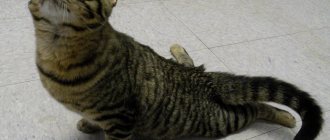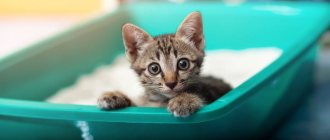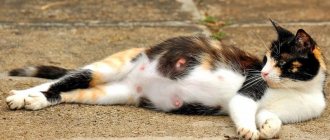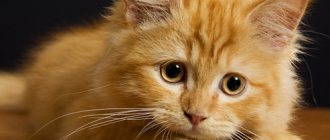6634Administration
There is simply no cat in the world that does not sharpen its claws. Indoor cats do this either with a scratching post or with indoor furniture. However, you should not be angry with the animal, because, most likely, the cat’s claws will peel off. There is also no need to panic about this, since this is a completely natural process. However, there is also an unpleasant problem that causes peeling of the claws. So, let's figure out in order why this happens and what to do when the claws of a mustachioed pet become exfoliated.
Your cat's claws are peeling - how to help
There is simply no cat in the world that does not sharpen its claws. Indoor cats do this either with a scratching post or with indoor furniture. However, you should not be angry with the animal, because, most likely, the cat’s claws will peel off. There is also no need to panic about this, since this is a completely natural process. However, there is also an unpleasant problem that causes peeling of the claws. So, let's figure out in order why this happens and what to do when the claws of a mustachioed pet become exfoliated.
Symptoms and possible complications
It is quite easy to notice an ingrown claw in your pet. The problem is indicated by atypical behavior of the pet:
- Since the sharp tip of the nail injures the soft tissues, the animal develops noticeable lameness. Painful sensations do not allow the cat to fully step on the damaged paw, and therefore he begins to limp.
- The pet pays a lot of attention to the sore limb. He constantly licks his foot and tries to bite off the offending nail with his teeth.
- The pet becomes inactive, lies down more, and does not show interest in regular games.
If you notice uncharacteristic behavior, you need to carefully examine your pet's paws. An ingrown nail is usually longer than the rest, strongly curved, and often stuck into soft tissue. When a mechanical impact is applied to the pad, the cat becomes aggressive, hisses, bites, and tries to escape from the hands.
Related article: Why does a cat lose hair and develop bald spots?
Pet constantly licks foot
If the problem is not corrected, it can adversely affect the quality of life of the furbaby:
- he will have a constant feeling of discomfort;
- pain or discomfort;
- habitual activity and mobility will be forced to decrease;
- lameness and unsteadiness of step will appear.
When an infection gets into the wound, inflammation often begins. If no action is taken, an abscess may develop, which can lead to sepsis.
Causes of claw separation
First of all, you should understand the reasons why claws begin to separate. This will not be difficult to do, since there are only 3 of them:
- Lack of vitamins. If a cat does not eat well, eating food that does not contain the necessary nutrients, then its claws begin to peel.
- Incorrect or poor nail care. If you decide to trim your pet's nails so that he does not spoil your things, then you should definitely do it correctly. Improper trimming of nails can cause them to split.
- Growth of claws. This is the most common reason why a cat's claws peel. During this process, the stratum corneum is renewed, and the claws fall into the scaly membrane, which over time lags behind and provokes detachment.
Of course, there is only one thing you should start worrying about - it is due to a lack of vitamins. But how can you independently understand that your mustachioed pet has a lack of vitamins in the body, and not just a banal growth of claws, and what to do when the claws peel off?
How to help your cat overcome split claws
There are several ways to help your cat deal with the problem of split claws:
- If a mustachioed dog has lost its claws, then a scratching post will help him cope with this problem perfectly. You can choose a floor-mounted, wall-mounted or corner scratching post, which is made of various materials that your kitten will like. Place it in your pet’s favorite place, and he will easily and independently get rid of the exfoliated shell, because of which he experiences discomfort every time he retracts his claws into his paw.
- In the case when you decide to cut the nails yourself, then for the first time it is better to contact a veterinarian, he will tell you and show you how to do it correctly so as not to harm your pet. After all, if after a haircut the cat’s claws begin to peel off, this is not the worst thing that could happen. It will be much worse if you touch the nerve endings with careless and incorrect circumcision, and the cat will experience unbearable pain. You can also provoke bleeding or inflammation of the cat’s claws, and then you definitely won’t have any problems.
- If your pet regularly uses a scratching post and you trim each nail correctly and efficiently, and the problem with delamination of the claws has not gone away, then you should still pay attention to its nutrition. You need to know that in this case the cat lacks vitamins and her claws peel off.
Help at the veterinary clinic
The extent of surgical intervention is determined by the doctor after a thorough examination of the animal. He evaluates the depth of the ingrowth, the degree of inflammation, and the general condition of the cat. If there are no complications, the doctor removes the problematic nail with a special tool, having previously treated the pad with an antiseptic. If inflammatory processes have already begun to develop, the operation is performed under local anesthetic. During the procedure, the veterinarian opens the abscess to remove the claw, pus, and clean out the wound. But very advanced cases require general anesthesia.
Similar article: Main symptoms and rules for treating microsporia in cats
After the manipulations, the doctor applies a sterile bandage with antibacterial ointment to the furry patient. To neutralize the inflammatory process, he prescribes a course of antibiotics, and for a speedy recovery, he prescribes mineral and vitamin complex preparations. If the animal is too weakened, it adds drugs that strengthen the immune system to the treatment regimen.
During the rehabilitation of the furry, it is necessary to regularly change the bandages. At the same time, you should not glue them with adhesive tape, so as not to further injure the surrounding tissues. If the cause of an ingrown toenail is genetic, the problem is likely to recur. During a relapse, it is best not to treat the animal yourself, but to contact a veterinarian for a second course of treatment.
After the manipulations, the doctor applies a sterile bandage to the cat.
Showing affection or claws still peeling off
In addition, you should remember that if a pet stomps in one place and puts out its claws, this does not mean that the kitten’s nails are peeling and he sharpens them on your knees or the carpet. He simply shows his affection in this way. In this case, there is such a thing as a “milk step”. Because tiny kittens squeeze out mother's milk from their mammary glands in this way. Thus, cats show sympathy for you, therefore, even if you are in pain because of the cat’s claws, still do not shout at the mustachioed one for it, because this is a kind of manifestation of love.
My cat's claws are falling out, what should I do?
So, how does a cat change its claws:
Natural change. Cats' claws grow quickly - this is how nature intended: they are needed for defense, and for attack, and for hunting, and for dexterous climbing. From time to time you may notice a “lost” claw. This is absolutely normal: the cat sheds the old keratinized “cases” from its new sharp claws. Usually such finds can be found near scratching posts.
Claw delamination. They flake, become disheveled, and look untidy. This shouldn't happen. The reasons must be determined.
Firstly, an incorrect haircut can lead to this. “Manicure” and “pedicure” for a cat should be done strictly with a special nail clipper. The tool must be sharpened to cut the claw in one go, not several times; it is necessary to cut it off, and not crush it and break it. Before the procedure, both the instrument and the claw should be disinfected. The very tip-hook is cut off, down to the blood vessels. In light-colored cats or those with white “socks,” the pink part of the claw is clearly visible.
You need to understand that this procedure is unpleasant for cats. If the animal has not been accustomed to trimming its claws since childhood, perhaps only a veterinary clinic can handle this matter.
Secondly, claws look untidy if a cat chews them. If the owners take care of their pet and its claws are trimmed and do not dig into the skin, then this bad habit has developed due to neurosis. The doctor will prescribe medications, and the owners will have to pay more attention and care to the animal.
A lack of vitamins and microelements, mainly calcium, also leads to problems with claws. A consultation with a veterinarian will be required. A balanced diet, selection of feed, and adding necessary substances to food will help.
Fungal diseases, naturally, like in humans, lead to problems with claws. Here, too, you can’t do without doctors. A fairly long course of treatment will be required. In advanced cases, it may come down to removing the entire finger.
Some internal diseases also affect the condition of the claws. An examination is required. Based on the results, the veterinarian will prescribe medications.
If the claws are peeling only on the front paws, but the hind paws are healthy, then most likely the animal was not provided with a scratching post. And the cat tries to grind off its overgrown claws on furniture and other inappropriate objects. It’s bad for both the owners and the animal. You urgently need to purchase a scratching post and accustom your pet to it. A drop of catnip infusion (sold in veterinary pharmacies) will speed up the process.
A doctor will help you determine exactly what is happening to your cat. An in-person visit to the clinic may not be necessary - in the Petstory application you can describe the problem and receive qualified help (the cost of the first consultation is only 199 rubles!). If the animal is healthy, but the problem persists, a zoopsychologist will help, whose advice can also be obtained in the Petstory application. You can download the application from the link.
Source
Panaritium (inflammation of the claw bed)
If we compare them with dogs, felons (inflammation of the claw bed) are much less common in cats. Normally, near the base of the claw there is a layer of dense, tough skin that protects the organ from negative environmental factors. Due to injuries, this layer is damaged, as a result of which bacterial and fungal microflora gain access to the soft tissues.
Most often, this disease occurs in cats living in rural areas and constantly walking outside.
Symptoms
The pathology has quite characteristic symptoms:
- Since inflammation is accompanied by severe pain, the cat prefers not to lean on the affected paw. If he has to do this, the pet hisses and meows strongly, “with anguish.”
- For the same reasons, the animal constantly licks and even gnaws its own paws.
- When examining the paws, it is clearly noticeable that the skin around the base of the claws is red, swollen, hot, and in many cases exudate oozes from there.
Treatment
As in the previous case, the treatment is not particularly difficult:
- The affected paw is kept in a saturated solution of Epsom salts (Epsom salt) three times a day for 10-15 minutes, or in a saturated solution of ordinary sodium chloride (table salt). This helps to pull exudate from the tissues and stop the inflammatory process.
- In severe cases (especially with the interference of putrefactive microflora), complete excision of the claw, and in some cases of the entire finger, is recommended.
- In most cases, broad-spectrum antibiotics are prescribed.
Why do they release claws?
It often happens that the cat marks time or lies on its knees and releases its claws at this time. Why a cat releases its claws is very important to know. After all, many owners begin to trim their cat’s claws and scold her when she puts out her claws at the wrong moment, but this is not recommended.
In fact, the phenomenon when a cat moves its paws and this is accompanied by the release of its claws is called a “milk step”. This comes from childhood, when kittens, when feeding on mother's milk, press on the mother's mammary glands with similar movements. Usually a milk step is a sign of affection from a cat, so you should never scold it. If these movements cause you discomfort, simply purchase soft silicone claw attachments.
Main causes of delamination
Three reasons why a cat's claws completely peel off.
- Growth of claws. Most often, a cat's claws peel off due to their growth, which is accompanied by renewal of the stratum corneum and placement of the claw in a special scaly sheath. It comes off over time and causes separation. At home, you should use a scratching post.
- Incorrect care. When a cat's claws peel off after a haircut. Detachment can begin due to improper care of the claws, namely due to sloppy trimming, which can greatly injure the claws. We wrote in more detail about how to trim a cat’s claws.
- Lack of vitamins. If there is a lack of essential nutrients that can enter the cat's body with food, claw separation may begin.
The first two reasons are absolutely natural. Particular attention should be paid to the third point.
Unbalanced feeding
Delamination indicates the carelessness of the owner. To ensure normal regrowth of claws, building material is needed, primarily vitamins. Most cat owners have no idea about the diet and feed them whatever they need: table scraps, raw fish or meat, milk, treats that the pet begs from the compassionate owner.
For owners, especially children, the sight of a pet eating something delicious evokes emotion, but such food does nothing but harm the cat’s health.
It’s even worse when the owner combines natural products with ready-made food. Nutrients enter into an antagonistic interaction and an imbalance of vitamins and other biologically active compounds develops. Owners thoughtlessly use vitamin supplements, which are sold in abundance in pet stores. However, in this case there is an excess of biologically active substances, which is more harmful than a deficiency.
The optimal solution to the problem is to use ready-made food of at least premium class. It contains all the necessary amino acids, vitamins, fatty acids, minerals that ensure the health of the pet, including its claws. Adherents of natural food will have to work hard: to create a diet from natural products that is not inferior in concentration of nutrients to ready-made premium food. In this case, you cannot do without vitamin and mineral supplements. And your veterinarian will help you choose.
What to do
There are several ways to solve the problem of claw separation:
- Scratching post. This unit will help the cat to independently get rid of the exfoliated shell of the claws by pointing them. The claw grinder can come in various shapes and sizes. They can be mounted on a wall, the back of a sofa, or any other place that the cat chooses for a claw point.
- Trimming nails. This procedure should be carried out very carefully so as not to damage the claws or cause bleeding and even greater separation. For the first time, it is better to contact a veterinarian who will trim the ends correctly and teach you how to do it yourself.
Tip: When trimming your pet’s nails yourself, you need to be careful and trim only the very tip. If you cut off more than necessary, you can touch the cat’s nerve endings and hurt her. In some cases, this can even lead to bleeding and inflammation.
But with an existing scratching post and regular trimming, you will still notice a clearly even separation of the claws. You may just need to feed your cat a balanced diet and give her extra vitamins for healthy nails. Only then will you and your pet forget about unnecessary stratification.
To completely forget about the problem of peeling claws in a cat and the negative consequences of this problem, pay attention to Anti-scratch. These products are made of soft silicone and are absolutely safe for your pet. They simply attach to the claws and prevent the cat from scratching everything he sees in his path, be it furniture or a small child. This product has many color options, which will allow you to choose it exactly to match the color of your pet.
Source
Treatment at home
Only a few know or have heard about what to do if a cat has an ingrown claw in its pad. A person’s first instinct is always to straighten the claw and pull it out with his hand. But this is absolutely forbidden.
To help his cat, the owner must have special clippers for trimming animal claws. The instrument should be disinfected with alcohol (cologne or vodka). The place where the claw has grown is also moistened with an antiseptic. An ingrown toenail is cut off before reaching the pink part where the blood vessels pass, so as not to damage them .
After trimming, the nail is removed from the pad by grabbing it by the edge with nippers or tweezers, with a sharp movement in the opposite direction of growth. It is important to do the removal quickly, as the procedure is painful and the cat will not like it. As a rule, the nail comes out easily without damaging nearby tissues.
© shutterstock
The place from which the defective nail was removed must be disinfected with hydrogen peroxide or furatsilin solution. You can also apply antibacterial ointment to the wound to prevent infection. The rest of the nail is shortened to the maximum possible height using a nail clipper.
Self-treatment can be carried out only if there is no inflammation at the site of ingrowth. If, upon examination, swelling and redness are detected at the site where the nail enters the soft tissue, then it is not recommended to treat the cat’s nail at home. Contact a specialist.
Claw growth
All domestic cats are known to have the ability to retract their claws. So, when there are particles of dead surface on a cat’s claws, the animal begins to experience unpleasant sensations when retracting its claws. It is for this reason that your pet may begin to sharpen its claws on your favorite sofa if you have not taken care to organize a separate place for this process. Also, through this action, cats mark their territory, since on their paws, in the area of the claws, there are glands that secrete an odorous substance that is not accessible to the human sense of smell, but is remarkably detected by the noses of other cats.
Why do cats show their claws?
It often happens that a cat, lying on the owner's knee, begins to trample and release its claws. Some people find this uncomfortable and rush to cut them off. However, this cannot be done. It’s just that such unfortunate owners did not ask themselves the question of the reasons for this behavior of the animal.
If they had bothered to find the answer to it, they would have known that such a phenomenon is called the milk step. This habit remains with cats from early childhood, when they were fed breast milk and, in order to speed up its flow, they massaged their mother’s tummy in the nipple area. So this phenomenon is based on the animal’s intention to express the warmest feelings and affection. You should not scold your pet for such a desire; it is better to buy him silicone attachments for his claws and such a massage will give you incomparable pleasure.
Main causes of delamination
There are several reasons why a cat has peeling claws:
- The claws just grow. This is quite normal and natural when, in the process of claw growth, the old stratum corneum dies off and the claw is placed with a scaly shell provided by the body, which, over time, separates and delamination occurs. To regulate this vital process, it is enough to use a special cat scratching post.
- Incorrect nail trimming. It happens that the claws begin to peel off immediately after they are cut. This is caused by an incorrectly performed procedure, which caused severe trauma to the claw. A blunt clipper may have been used.
- Lack of appropriate vitamins in the pet’s body. This is a fairly common reason, because the bones, claws and fur of an animal primarily react to the lack of substances necessary for their proper growth.
Moreover, if the first reason does not require much concern, the second can be corrected by changing the method of cutting the claws, or by replacing the device, then the last reason requires more careful attention.
Fungal infection
A fungal infection on the claws is one of the most serious options. These pathologies are difficult to diagnose and difficult to treat.
In addition, the drugs used during treatment are dangerous not only for pathogenic fungal microflora, but also for the cat itself (due to the high toxicity of these compounds).
Symptoms
The claws themselves are affected by the fungus in rare cases and this happens, as a rule, only in animals with extremely weakened immunity. In cats, infection is usually caused by representatives of the genera Microsporum and Trichophyton, sometimes the disease is caused by yeast from the genus Malassezia.
The following symptoms indicate a fungal infection:
- When the claw tissue is affected, it becomes porous, brittle, cloudy or translucent. In severe cases, with light pressure, the claw breaks off easily and effortlessly.
- In addition, strange sores and growths appear on the paw pads and in the space between the toes, and hair falls out in regularly shaped, rounded areas.
- Malassezia may smell like old cheese.
Treatment
In this case, treatment is much more difficult. For mild cases of the disease, a regular alcohol tincture of iodine can help, which can be applied to all claws up to four times a day. This requirement is associated with the high contagiousness of fungal pathologies. But these are only half measures; these diseases can only be cured with special medicines.
Antifungal drugs
The following antifungal drugs may be used:
- Fluconazole. It is considered one of the safest drugs, but it is not very effective against some pathogenic fungal strains.
- Itraconazole The highest quality, effective and at the same time completely safe drug. The only drawback is its cost. In addition, you have to buy it in regular pharmacies.
- Terbinafine. In some ways similar to the previous remedy. Also not approved for veterinary use.
The dosage, frequency and duration of treatment with all these medications should be determined exclusively by a veterinarian! They are too dangerous for uncontrolled use.











